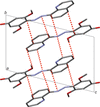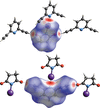issue contents
July 2022 issue

Cover illustration: The X-ray structures of three 1:1 cocrystals formed between reactive diethynylpyridine and N-halosuccinimide partners are reported. Each cocrystal features a short halogen bond and two short complementary nonconventional C—H⋯O hydrogen bonds. See Bosch & Bowling [Acta Cryst. (2022), C78, 424–429].
research papers
Download citation


Download citation


The bond lengths of 8-[1-(2,6-dimethoxyphenyl-4-hydroxy)diazenyl]quinoline are typical for the structure of a quinoid hydrazone. The changes in the absorption spectra when the pH of the buffer was varied suggested the production of an azo form by deprotonation. We report the synthesis, X-ray crystal structure and acidity.
Download citation


Download citation


Two coordination polymers were rationally designed and successfully constructed using the rigid multicarboxylic ligand biphenyl-3,3′,5,5′-tetracarboxylic acid (H4BPTC) and rare-earth-metal ions (Eu3+ and Ho3+) under solvothermal conditions. The polymers both possess a two-dimensional structure and display good thermal stability and photoluminescence with an orange–red light emission.
Download citation


Download citation


Open  access
access
 access
access3-Phenyltetrahydropyrimido[4,5-c]pyridazine 2′-deoxyribonucleoside shows two conformations in the crystalline state with distinct differences observed for the sugar moiety (N versus S sugar pucker). The nucleoside mimics the recognition face of dT and forms stable base pairs with dA.
CCDC reference: 2176720
Download citation


Download citation


Thiophene-based molecules are of great importance in terms of their biological activity. N-(Thiophen-2-ylmethyl)thiophene-2-carboxamide is found to have an effective antibacterial activity due to the presence of S atoms and an amide functional group in the structure.
CCDC reference: 2165128
Download citation


Download citation


A cadmium(II) coordination polymer prepared by the reaction of Cd(NO3)2·6H2O with cis-cyclohexane-1,2-dicarboxylic acid and 4,4′-bis(2-methyl-1H-imidazol-1-yl)biphenyl in a mixture of H2O and dimethylformamide, possesses a 6-connected hxl two-dimensional layer based on Cd6(CHADC)6 clusters with the point symbol (36·46·53). The coordination polymer displays a highly selective and sensitive sensing for Fe3+ cations and Cr2O72−/CrO42− anions through luminescence quenching effects in aqueous solutions.
CCDC reference: 2181080
Download citation


Download citation


A new mixed-valence CuI/CuII three-dimensional coordination polymer incorporating 2-(pyrazin-2-yl)quinoline-4-carboxylic acid was synthesized and characterized. The ligand was also isolated as its hydrated hydrochloride salt. The compounds show luminescence and the ligand structure was rationalized by means of quantum-chemical calculations.
Download citation


Download citation


In two crystalline solids (a cocrystal and a salt) of 5-aminotetrazole, the crystal packing arrangements are governed by N—H⋯O and O—H⋯O hydrogen-bonding interactions. The Hirshfeld surface analysis and fingerprint plots reveal that O⋯H/H⋯O interactions contribute 34.4% of the total interactions in the crystal packing of the cocrystal and 36.7% in the salt.
Download citation


Download citation


The X-ray structures of three 1:1 cocrystals formed between reactive diethynylpyridine and N-halosuccinimide partners are reported. Each cocrystal features a short halogen bond and two short complementary nonconventional C—H⋯O hydrogen bonds.


 journal menu
journal menu

























